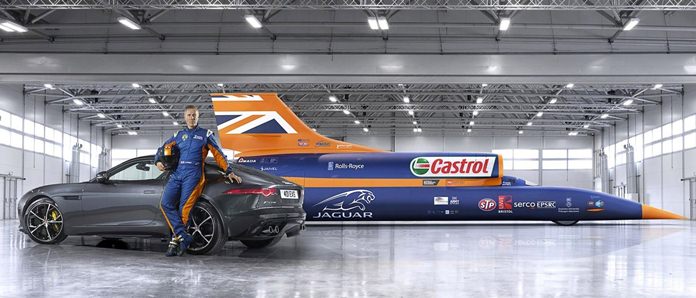
The record-seeking Bloodhound Supersonic Car has completed two trial runs on a 2.7 km long runway in England.
 A crowd of more than 3000 people watched the jet powered car successfully reach its goal of 322 km/h from a standstill in just over 8 seconds and go on to a top speed of 340 km/h. It was a walk in the park for the driver, Royal Air Force Wing Commander Andy Green who set the current land speed record of 1227km/h two decades ago.
A crowd of more than 3000 people watched the jet powered car successfully reach its goal of 322 km/h from a standstill in just over 8 seconds and go on to a top speed of 340 km/h. It was a walk in the park for the driver, Royal Air Force Wing Commander Andy Green who set the current land speed record of 1227km/h two decades ago.
“We did two back-to-back 200 mph runs in a five-tonne car. It felt like about eight seconds, which was what we were expecting,” Green told BBC News.
“It was a real hard work-out for the brakes. Probably up to somewhere close to a thousand degrees, the front brakes were smoking furiously after the second run. They just started to flicker with flame – very sort of Formula One, but in a proper high-speed car. And that was exactly what we were hoping for,” he said.
The high-speed runs are only a public shakedown for the Bloodhound SSC which is hunting a new land speed record in the next few years. However, the Rolls-Royce EJ200 jet engine that currently powers the car will only reach a maximum speed of 1050 km/h – almost 600 km/h less than the target.
To get there, the team plans on replacing the car’s current jet-powered engine with a hybrid rocket propulsion system built by Norwegian aerospace and defence company, Nammo. The higher Vmax will also necessitate changes to the vehicle’s aerodynamic design at the rear.
“The total thrust we think we need is about 20 tonnes. So that’s a thrust-to-weight ratio of about two-and-a-half. The car when we’re breaking records will weigh about eight tonnes,” said Bloodhound technical director, Mark Chapman.
Additional changes to the car may include substituting its Jaguar V8 powered fuel pump for an electric system that can distribute its weight more evenly.
Nammo’s technology, which isn’t available until at least 2020, will push the car to a top speed of around 1610 km/h and smash through the sound barrier. If all goes to plan, Green will pilot the car and notch his name in the record book for a third time, having set the world’s previous two records at Black Rock Desert in the USA.
The 2020 record attempt will require an even longer stretch, likely to be the 19 km wide Hakskeen Pan dry lake bed in South Africa.
I have driven at 300 km/h in an F5000 race car and it seems blindingly fast. What it is like at over 1000 km/h almost defies imagination.





